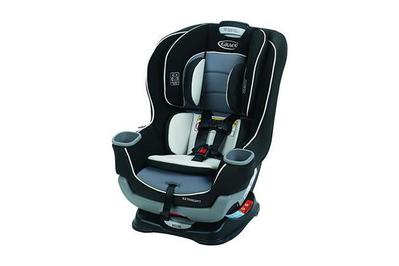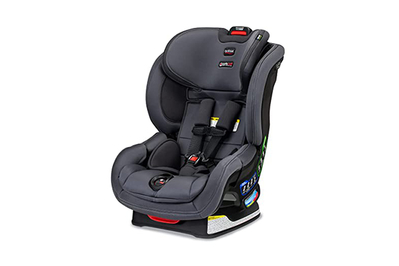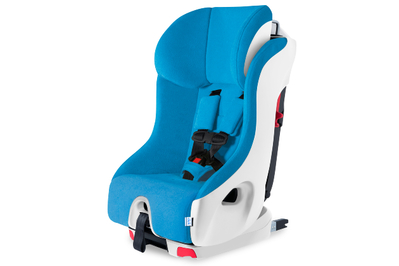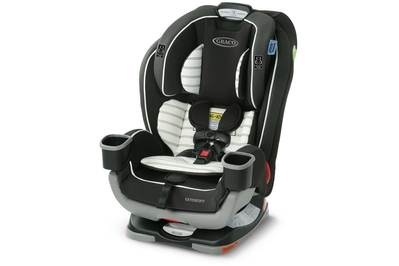As the name implies, a convertible car seat is designed to evolve as your child grows. Your baby will be ready for this larger, five-point safety harness seat once they’ve outgrown their infant seat’s height and weight limits (usually around 30 inches or 30 pounds); this will likely happen at any point between 6 months and 2 years of age. Once you transition to the convertible seat, you’ll start out with a baby or toddler sitting in it rear-facing and eventually end up with a much bigger kid riding in it forward-facing. Getting the hang of convertible seats can be daunting—what with their various installation modes and positions, multiple seat belt paths, and safety tethers—which is why we set out to find the models that are the simplest and safest to install and use. Whatever seat you choose, we’ve also included plenty of helpful tips on how to navigate the road ahead.
Our pick
The Graco Extend2Fit Convertible has a lot going for it, including pretty easy installation, thoughtful features, and great value for the price. But most importantly, this seat excels at keeping your kid comfortable while they ride rear-facing—the safest position for a young child—for longer. Many large toddlers and preschoolers struggle to stay rear-facing in their car seats because at a certain point they start to feel squashed. The Extend2Fit Convertible addresses that problem by adding an extension panel to the seat that pulls out to provide 5 inches of extra legroom in rear-facing mode. Kids can remain rear-facing in the Extend2Fit Convertible until they reach 50 pounds, the highest capacity of the seats we tested. (Our also-great convertible pick, the Clek Foonf, has a 50-pound rear-facing weight limit too.) We found installing the seat to be quick and intuitive, particularly when using LATCH (which stands for Lower Anchors and Tethers for Children, a system that lets you attach a pair of metal hooks on the seat to a set of anchors built into the car). The Extend2Fit Convertible’s LATCH install system can be used for children who weigh up to 45 pounds, the highest LATCH weight limit of any of the seats we tested. Also, the seat is lightweight and has a no-rethread harness, so as your kid grows, you don’t have to take the seat apart to adjust the straps. Even though the fabric isn’t as stain resistant as we’d like (consider going with a dark color), the cover is machine washable.
Weight of seat: 19 pounds
Seat dimensions: 18.5 inches wide by 23.7 inches tall (with the headrest in its lowest position)
Passenger rear-facing weight and height range: 4 to 50 pounds; head must be at least 1 inch below the headrest’s handle
Passenger forward-facing weight and height range: 22 to 65 pounds; up to 49 inches tall (the top of the child’s ears must also be below the top of the headrest)
Runner-up
The Britax Boulevard ClickTight is a stylish and user-friendly seat that stands out for its incredibly easy installation. It features Britax’s innovative ClickTight installation system: You thread the vehicle’s seat belt through a path beneath the Boulevard’s seat cushion and close the seat cushion, and then a built-in mechanism tightens everything securely into place—no grunting, sweating, or swearing required. (You can also use LATCH to install the Boulevard, but Britax recommends the seat belt method, and we agree.) Like our top pick, the Graco Extend2Fit Convertible, the Boulevard has a no-rethread harness that makes ongoing strap adjustments hassle-free. But like the majority of convertible seats out there, this seat can only be used in the rear-facing position for kids weighing up to 40 pounds (10 pounds less than with our top pick). And in our experience, the Boulevard doesn’t provide much legroom in rear-facing mode, so it may encourage caregivers to turn their kids forward-facing sooner than experts recommend. If keeping your child rear-facing for as long as possible is the number-one priority, then we think you’d be better served by our other picks. However, if a fast and convenient install matters most, then the Boulevard is your best bet.
Weight of seat: 29.4 pounds
Seat dimensions: 18.5 inches wide by 23.5 inches tall (with the headrest in its lowest position)
Passenger rear-facing weight and height range: 5 to 40 pounds; head must be at least 1 inch below the top of the headrest
Passenger forward-facing weight and height range: 20 to 65 pounds; up to 49 inches (the top of the child’s ears must also be below the top of the headrest)
Also great
The Clek Foonf offers an appealing combination of safety features, handsome aesthetics, and clever engineering. At 38 pounds, it’s heavy as all get-out—something people are likely to either love (because it feels like a tank) or hate (because it’s a monster to move). Similar to the Graco Extend2Fit Convertible, our top pick, the Foonf can comfortably accommodate a child in the rear-facing position until they reach 50 pounds. This seat doesn’t have a pull-out extension for added legroom like the Extend2Fit Convertible does. But the design of the Foonf and the way it reclines both make it feel roomy and spacious when rear-facing, even for taller kids. The Foonf also comes with an added safety feature: an anti-rebound bar, which is a steel support piece that, in the case of a crash, can help to reduce the rebound motion of the seat. Installing the Foonf in the forward-facing position with LATCH is beyond easy. However, the rear-facing install of the Foonf is a bit tricky—it definitely requires more force and effort than either the Graco Extend2Fit Convertible or the Britax Boulevard. Once the Foonf is installed, it feels rock-solid, but it may be a better fit for families that don’t need to move the seat frequently, especially when it’s in rear-facing mode. The Foonf’s footprint—17 inches at its widest point—is among the narrowest in the convertible category, which makes it a good candidate for families that need to fit three seats across in a single row. The seat comes in a range of stylish, sophisticated color and fabric options, and the material is unusually easy to keep clean.
Weight of seat: 33 pounds when forward-facing, 38 pounds when rear-facing (with added base and anti-rebound bar)
Seat dimensions: 13 inches wide at the base, 17 inches at the widest point, and 28 inches tall (forward-facing, with the headrest in the lowest position)
Passenger rear-facing weight and height range: 14 to 50 pounds (or 5 pounds if you purchase a Clek Infant-Thingy); 25 to 43 inches (19 inches with use of the Infant-Thingy)
Passenger forward-facing weight and height range: 22 to 65 pounds; up to 49 inches (the top of the child’s ears must also be below the top of the headrest)
Also great
An all-in-one car seat is meant to be a utility player: It can be used as a rear-facing infant seat, a rear-facing toddler seat, a forward-facing toddler and big kid seat, and finally a booster seat. Buying a single car seat (versus three or even four) is cost-effective, and it sounds like a genius idea, in theory. But we’ve found that each individual type of seat tends to do a far better job at its dedicated purpose than an all-in-one seat can. So we think most families will be happier going with an infant seat, then a convertible seat, and then a booster seat. However, if you do decide to buy an all-in-one, the Graco Extend2Fit 3-in-1 is a solid choice. It’s the all-in-one version of our top-pick convertible seat, the Graco Extend2Fit Convertible, and it has all of the same features, including an extension panel for added legroom—to enable kids to remain rear-facing for longer—and a no-rethread harness. The straightforward installation, whether via seat belt or LATCH, is the same, too. But the LATCH method, which we prefer, can only be used until your child reaches 40 pounds. (The Extend2Fit Convertible has a 45-pound LATCH limit.) Also, the Extend2Fit 3-in-1’s highest shoulder-harness setting is over an inch shorter than the one on the regular Extend2Fit Convertible, so you may end up needing to switch your kid from convertible to high-back booster mode sooner than you’d like.
Weight of seat: 21.9 pounds
Seat dimensions: 19 inches wide by 24.5 inches tall (with the headrest in its lowest position)
Passenger rear-facing weight and height range: 4 to 50 pounds; head must be at least 1 inch below the headrest’s handle
Passenger forward-facing weight and height range: 22 to 65 pounds; up to 49 inches (the top of the child’s ears must also be below the top of the headrest)
Passenger booster mode weight and height range: 40 to 100 pounds; 43 to 57 inches; also, at least 4 years old (but most experts recommend waiting until at least age 5)








